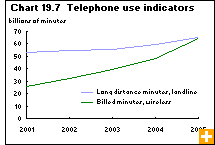Common menu bar links
Life in digital times
Archived Content
Information identified as archived is provided for reference, research or recordkeeping purposes. It is not subject to the Government of Canada Web Standards and has not been altered or updated since it was archived. Please contact us to request a format other than those available.
The introduction of digital technology brought predictions of a paperless society and the end of traditional mail. Neither of these predictions has yet come true, but the widespread use of ICTs have brought about some interesting shifts in behaviour.
The arrival of the personal computer was supposed to lead to the paperless office. However, from 1985 to 2005, estimated consumption of printing and writing paper in Canada increased 73%, and most of that growth occurred from 1985 to 1995.
The volume of postal mail has also been rising. In 2006, Canada Post delivered 11.6 billion pieces of mail and parcels, including about 9 million Census forms for Statistics Canada. Couriers and local messengers are proliferating, even with the high usage of Internet and e-mail.
One extremely visible outcome of ICTs is that the information society is a talkative society. Canadians have never spoken on the telephone more, despite also sending and receiving massive amounts of e-mail and other electronic communications. As people communicate more and in different ways, they are choosing to expand their associations, moving from geographically defined communities to communities of interest.
They are also willing to pay for their choices, as consumer spending patterns show. From 1997 to 2005, average annual spending by households on Internet services rose from $30 to $241. In the same period, spending on wireline telephone services dropped from $725 to $640.



